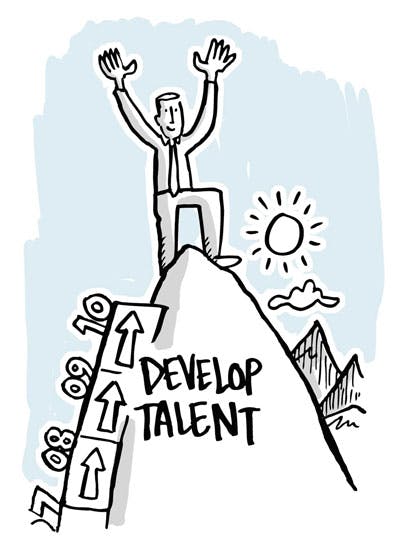Almost three years ago, Neil Nicoll, President and CEO of YMCA said in Finding Leaders for America’s Nonprofits: Commentaries, “Until [we] become much more intentional about development of internal talent, we are doomed to an ever-growing leadership deficit.”
And yet, while many organizations are recruiting leaders from competitors (with cost per hire only rising), few are doing much to develop the talent they have into the leaders they need.
Here’s what I don’t understand: Why is the process of finding a leader – whether to backfill someone or to fill a new role – often treated as an isolated event rather than an ongoing process?
Why you should develop leaders from within
One would think more organizations would be proactive in identifying and cultivating leaders within their existing talent pool. While some companies have begun taking measures to that end, the leadership deficit Nicoll predicted has largely become a reality.
A change has to occur in the way companies are sourcing leadership talent. Rather than look outward when a leader is needed, they should instead continuously look inward to identify candidates with leadership aptitude and invest in honing their skills with development programs.
Regardless of whether you ultimately hire leaders from within, simply having a leadership development program yields important benefits for any organization. Here are reasons to do it:
1. Boost employee engagement and morale
Employee engagement continues to gain weight as a key performance indicator for an organization’s success. However, a study conducted by ACCOR found that although 90 percent of leaders say employee engagement impacts business success, 75 have no engagement plan or strategy.
To that end, development programs give employees the opportunity to strive toward something more meaningful and valuable than their day-to-day work. And that makes them happy.
While development programs are proven to boost both engagement and morale, however, the success of your program is contingent on alignment with business goals. “It’s not about the volume of training as much as it is the caliber,” says Larry Gregory, VP of Strategy and Marketing for the DeSai Group. “Your leadership program must be able to catalyze business results.”
Leadership development is serious stuff. It takes time and dedication to make it work. If you’re going to adopt an official leadership development program, be sure to first identify your goals for the program.
2. Increase employee performance
It’s hard to deny a linkage between development and performance. As John Robak, Executive Vice President and Chief Operating Officer at Greeley and Hansen, attests, “Those individuals in our organization who are inspired tend to outperform. That’s because the more well-rounded you are, the better you’re able to perform.”
When you’re teaching people how to manage and coach, you’re teaching them how to motivate the people around them.
“They learn how to identify potential and inspire people to reach their max,” says Beth Miller, Vistage Chair and President of Executive Velocity. “And for leaders to invest time and energy in them, it communicates a real value of getting their employees to their maximum potential.”
Makes sense, right? The companies outperforming you certainly think so. In fact, the highest performing organizations spend 36% more on development than their less successful counterparts. As Miller notes, “The ones that are doing this effectively understand what their future needs are going to be, and understand how to engage their potentials and give them the opportunity to develop the skills that they need to succeed in the operation.”
3. Improve retention rates
Many organizations see investments in employee development–leadership development, in particular – as a gamble. If the employee leaves, those investments walk out the door and potentially into the hands of a competitor. For those who cite turnover as a reason not to invest in developing employees, though, the truth is that leadership development and opportunities are actually a leading retention strategy.
“Gen Y tends to be more fluid and move more frequently, which can be intimidating for employers worried about turnover. We see the exact opposite,” says Robak.
Don’t get me wrong – turnover is a valid concern when talking about development, but if you’re hemorrhaging top performers, it’s rarely because you’ve invested too much in developing them. “For staff with high-growth potential, it’s easier than ever for them to see what your competitors are doing,” warns Gregory. “If you’re not giving them a chance to innovate and do more, they’re going to look elsewhere.”
Making leadership development with any budget
Good leadership development isn’t about which products, services or organizations you use to build or beef up your programs.
Hokey as it sounds, it’s about creating meaningful work and experiences that develop skills your employees need to succeed as managers and directors, while developing a pool of leadership candidates within your organization. It’s a win-win.
And you can do this without breaking the bank. For instance:
- Implement coaching and mentoring programs with top performers.
- Assign cross-training projects that give exposure to other departmental issues.
- Task them with managing an intern or seven, with a list of deliverables to execute on.
Seminars and workshops where leadership potentials are submerged in training are also valuable, but can be expensive. If you can’t afford to send every high potential employee off to a training seminar, inject some gamification into the process. Buy one pass, and have them compete for it.
Closing thoughts: Transparency is King
As Robak points out, “In the absence of feedback, people tend to create their own.” Whatever decision is made–whether it’s a promotion from within or an external hire, it’s critical to communicate the why. Robak goes on to say that, “We don’t just want our message to be heard–we want to ensure it’s received.” Otherwise, all of your best intentions are for naught.
What successes have you had in developing leaders internally? What challenges is your organization faced with when developing a pool of leadership candidates?
This originally appeared on Kyle Lagunas’ Software Advice blog.
